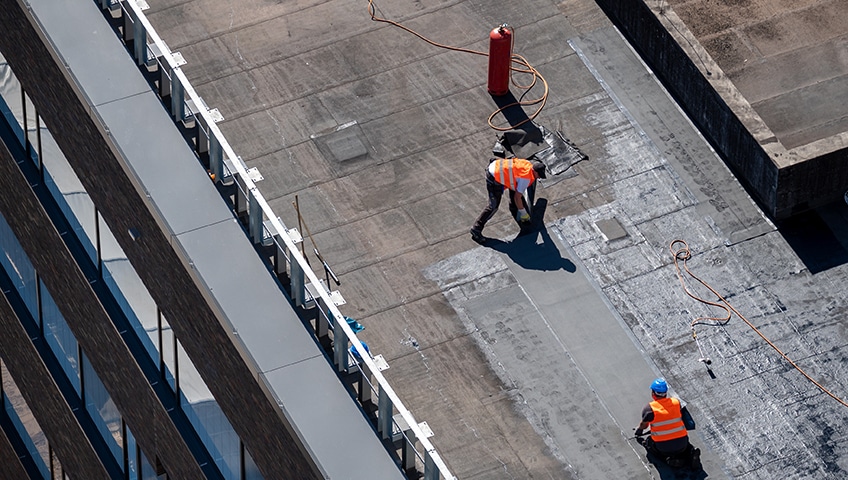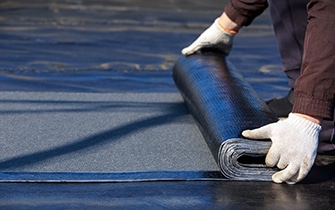
Roof coatings play a vital role in protecting your roof and extending its lifespan. It provides enhanced UV protection, reduces contraction and expansion cycles that can lead to premature membrane failure, and prevents water retention issues. Choosing a roof coating is often more cost effective than replacing the entire roof. However, choosing the right coating depends on several factors, including the roof’s location, condition, slope, and exposure to various elements such as heat, chemicals, and ultraviolet light. There are a variety of coatings available, so it’s important to weigh the pros and cons to find the best one for your roof.
General advantages and disadvantages of flat roof coatings
advantage
- Increased reflectance: Reflective roof coatings are designed to reflect more sunlight and absorb less heat than traditional roofing materials. This feature is especially beneficial for buildings in warmer climates, as it can significantly reduce cooling costs. These coatings keep roof surfaces cool by reflecting UV rays, reducing heat transferred into the building. This not only extends the life of the roof by preventing damage from overheating and UV rays, but also contributes to a more comfortable indoor environment without relying heavily on the air conditioning system.
- cost effective: Applying a roof coating is a cost-effective way to extend the life of your existing roof without having to completely replace it. Roof coatings provide an affordable solution to sealing leaks and minor damage and increasing the durability of your roof. This preventive maintenance can save you significant money in the long run by avoiding expensive emergency repairs and extending the time between roof replacements. Additionally, energy savings from improved roof reflectivity reduce utility bills, further increasing economic benefits.
- Weatherability: High-quality roof coatings are designed to withstand extreme weather conditions such as heavy rain, strong winds, and temperature fluctuations. Forms a seamless barrier that resists moisture penetration, preventing leaks and water damage. Additionally, these coatings expand and contract with the roofing material during temperature changes, reducing the risk of cracks and tears forming on the roof surface. This resiliency makes it an excellent choice for protecting your roof from weather wear and tear.
Cons
- pond water: One of the main challenges with flat roof painting is the potential for water to collect. Flat roofs inherently trap water more easily because they have minimal slope. Some roof coatings may not be effective enough to prevent water infiltration in areas prone to water retention for long periods of time. Prolonged exposure to standing water can degrade the coating, lead to leaks, and reduce the overall effectiveness of your roof’s protective barrier. It is important to carefully plan and execute coating applications to reduce these risks, including ensuring proper drainage.
- Reflectance loss: Many roof coatings are initially highly reflective, but their ability to reflect UV rays can decrease over time. Factors that contribute to this loss include the accumulation of dirt, debris, and other particles that settle on the roof surface. Dirty coatings can reduce reflectivity, increase surface temperatures, and reduce energy efficiency within buildings. Regular maintenance and cleaning is essential to maintain the reflective properties of the coating and ensure continued energy savings.
- retain dirt: Roof coatings, especially those with sticky or sticky finishes, can attract and retain dirt, leaves, and other debris. This not only affects the aesthetic appearance of the roof, but can also affect its functionality. Debris buildup can obstruct your roof’s drainage system, leading to water retention and associated problems. Additionally, a dirty roof coating may require more frequent cleaning to maintain its reflectivity and performance, increasing maintenance costs.
Advantages and disadvantages of various flat roof coatings
- acrylic roof coating: Acrylic coatings are water-based, so they are environmentally friendly and easy to apply. It has excellent reflectivity and reduces cooling costs by reflecting UV rays. Acrylic coatings are ideal for areas with mild climates, as extreme cold can reduce their flexibility and make them more susceptible to cracking. Over time, weathering can thin the coating and require reapplication to maintain effectiveness.
- silicone roof coating: Silicone coatings are known for their excellent water resistance and ability to withstand standing water without degrading, making them ideal for flat roofs where water accumulation is a concern. Its inert nature maintains its reflectivity over time, even in dirty conditions. However, silicone gets dirty easily and can be slippery when wet. Silicone coatings are durable, but more expensive, and recoating may require special preparation.
- polyurethane roof coating: These coatings are highly resistant to physical damage and foot traffic, making them suitable for roofs that are frequently accessed. There are two main types: aromatic (less UV stable and cheap) and aliphatic (more UV stable and expensive). Polyurethane coatings have excellent water resistance, but can be more difficult to apply because they are sensitive to moisture during application.
- spray foam: Spray polyurethane foam (SPF) is both insulating and waterproof, making it versatile for roof coatings. It can create seamless layers and significantly improve the energy efficiency of buildings. However, SPF must be applied by a professional and requires precise conditions for application. It is also essential to apply a protective top coat to protect the foam from UV rays and physical damage.
- Thermoplastic roof coatings (TPO & PVC): Thermoplastic coatings such as TPO (thermoplastic olefin) and PVC (polyvinyl chloride) are highly reflective and resistant to UV light, chemicals, and punctures. It is particularly suitable for commercial applications as it is durable and requires low maintenance. Applying thermoplastic coatings requires a skilled roofing contractor and heat welding equipment, which can increase initial costs.
Roof painting and roof re-roofing
roof painting: A viable option to extend the life of your roof without the high costs associated with a complete roof replacement. Ideal for roofs that are generally in good condition but need additional protection or minor repairs.
Re-roofing: Required if the roof is beyond repair. Although expensive, it provides a long-term solution for roofs that are severely damaged or nearing the end of their useful life.
Talk to a trusted commercial flat roofing contractor for the best solution


